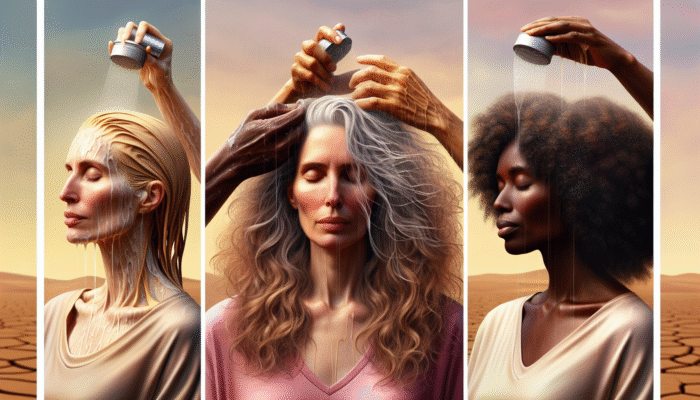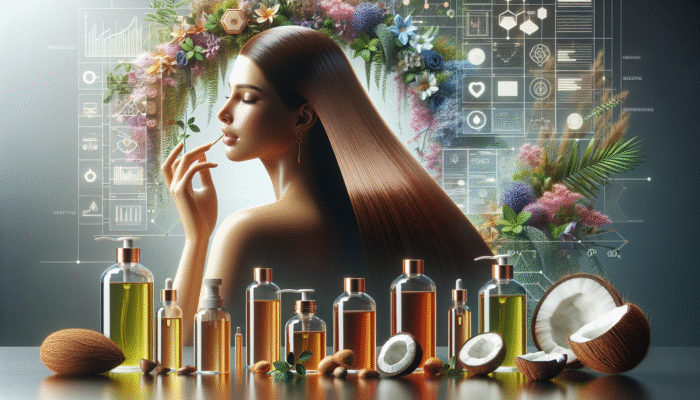Mastering Hair Washing Techniques for Luxurious, Salon-Treated Hair
Becoming proficient in the art of washing is crucial for sustaining the vitality and lustrous appearance of your salon-treated hair. This essential routine not only safeguards your investment in professional hair treatments but also ensures that your strands remain healthy and visually appealing. By grasping the subtleties of effective washing techniques, you will establish a solid foundation for achieving hair that not only shines but also exudes confidence. Consistently applying these methods will aid in preserving your hair's natural sheen and vibrancy, making it resilient against the rigours of daily wear and tear.
Discovering the Ideal Washing Frequency Based on Your Unique Hair Type

For a variety of hair types, washing your hair every 2-3 days is generally regarded as the most effective frequency. This schedule allows your scalp to produce natural oils that nourish both your scalp and hair, helping to prevent dryness that can lead to breakage and lacklustre strands. However, it’s vital to recognise that this guideline does not apply universally. Individuals with oily hair may require more frequent washing, while those with dry or curly hair might find that extending the intervals between washes yields better results. For example, if you live in a humid environment, the increased oil production might necessitate washing more regularly; conversely, individuals residing in drier climates may discover that fewer washes help retain their hair's moisture levels.
Experimenting with various washing frequencies will aid you in discovering the perfect routine tailored to your specific hair needs. A practical method is to observe how your hair reacts after a few days without washing. This close examination will assist you in determining the optimal balance that keeps your hair looking fresh and bursting with vitality while preserving its essential oils.
Selecting the Ideal Shampoo to Care for Your Salon-Treated Hair
Choosing a sulfate-free shampoo is essential for maintaining the integrity of your salon-treated hair. Sulfates have the potential to strip away both colour and moisture, leaving your hair appearing frizzy and lifeless. It is advisable to select shampoos specifically formulated for coloured or treated hair; these products often contain ingredients designed to retain moisture and amplify shine.
Numerous brands now provide specialised formulations tailored to cater to various hair types. For instance, if you possess fine hair, opt for a lightweight shampoo that won’t weigh it down. Conversely, those with thicker, coarser hair may benefit from a more hydrating formula that nourishes without adding excess weight. Always scrutinise product labels to ensure they align with your specific hair needs and goals, facilitating the achievement of optimal results.
Optimising Water Temperature for Healthier Hair Maintenance
The temperature of the water utilised during your hair washing routine significantly impacts its overall health. It is recommended to use lukewarm water, as hot water can strip away essential oils, leaving your hair dry and brittle. Hot water opens the hair cuticle, potentially leading to increased damage and fading of colour.
To further enhance your hair’s health, contemplate a final rinse with cool water after conditioning. This cool blast helps seal the cuticle, effectively locking in moisture and colour, which is especially beneficial for salon-treated hair. This straightforward yet powerful technique can dramatically improve both the appearance and health of your locks, making them look vibrant and full of life.
Advanced Conditioning and Moisturising Strategies for Exceptional Care of Salon-Treated Hair

Effective conditioning is paramount for keeping your salon-treated hair hydrated and easy to manage. By adopting the appropriate conditioning and moisturising practices, you can preserve the quality of your hair while maintaining the integrity of the professional treatments you’ve undergone.
Integrating Deep Conditioning Treatments into Your Routine for Maximum Benefit
Incorporating deep conditioning treatments into your hair care routine at least once a week is essential for sustaining its overall health. These treatments penetrate deeply into the hair shaft, delivering critical moisture and nourishment. Seek out products infused with beneficial ingredients such as keratin, shea butter, and protein to restore strength and elasticity to your locks.
Transform your deep conditioning application into a rejuvenating ritual. After washing, generously apply the treatment, focusing on the ends of your hair, where damage is often most prominent. For enhanced absorption, consider wrapping your hair in a warm towel or using a heated cap. Allow the product to work its magic for the recommended duration, typically ranging from 20 minutes to an hour, depending on the specific instructions provided.
Daily Use of Leave-In Conditioners for Optimal Hydration and Protection
Incorporating a leave-in conditioner into your daily hair care routine can significantly enhance your efforts to maintain salon-treated hair. These products provide immediate hydration while also serving as a protective barrier against environmental stressors. It’s prudent to select leave-in conditioners that offer UV protection, as sun exposure can fade colour and inflict damage on your hair.
For optimal application, use a small amount on damp hair, concentrating on the mid-lengths to the ends. A lightweight formula will ensure your hair remains soft and manageable throughout the day without feeling weighed down. By consistently using a leave-in conditioner, you can significantly diminish frizz and flyaways, making your hair easier to style and manage.
Utilising Natural Oils for Enhanced Hydration and Shine

Natural oils, including argan, coconut, and jojoba, can be incredibly advantageous for maintaining salon-treated hair. These oils are rich in essential fatty acids and vitamins that nourish and hydrate your hair, enhancing its natural shine. Notably, argan oil is celebrated for its ability to tame frizz and create a silky finish.
By applying a small quantity of oil to the ends of your hair, you provide added protection against heat styling and environmental damage. Additionally, consider blending a few drops of these oils with your deep conditioner for an extra moisture boost, ensuring your hair remains vibrant and healthy.
Heat Styling Safeguards to Protect the Integrity of Salon-Treated Hair
Heat styling can serve as both a blessing and a curse for salon-treated hair. While it offers the flexibility and creativity required for various hairstyles, it also presents a considerable risk of damage. Understanding how to mitigate this damage is essential for keeping your hair looking its absolute best.
The Essential Role of Heat Protectants in Hair Care Routines
Before employing any styling tool, it is imperative to apply a heat protectant spray. These products create a protective barrier around the hair cuticles, significantly diminishing the direct impact of heat exposure. Seek out heat protectants that contain silicones or nourishing oils, as these components shield your hair from high temperatures while imparting a radiant shine.
Evenly spray the product on damp or dry hair before styling, ensuring to section your hair for thorough coverage. This vital step can make a substantial difference in maintaining the health of your salon-treated hair, enabling you to enjoy your preferred styles without compromising their integrity.
Strategies to Reduce Heat Exposure and Protect Your Hair
Although the urge to style your hair daily can be enticing, reducing the frequency of heat styling can greatly enhance your hair's health. Aim to limit heat exposure by embracing air-drying or opting for heatless styling techniques whenever possible. Styles such as braids or buns can be achieved without relying on heated tools.
If heat styling is necessary, designate specific “heat-free” days to allow your hair to recuperate. This approach not only protects your salon-treated hair but also encourages you to experiment with new styles that don’t require heat, ultimately reducing long-term damage.
Identifying the Optimal Styling Temperatures for Your Hair Type
Being mindful of the temperatures used while styling your hair is crucial. Setting your styling tools to the lowest effective temperature can significantly minimise the potential for damage. For instance, while many stylists suggest a temperature of around 180°C for straightening, starting at a lower setting can often yield comparable results without jeopardising your hair's health.
Take the time to experiment with lower temperatures and closely monitor how your hair responds. Using styling tools equipped with adjustable temperature settings allows you to discover the perfect balance that effectively styles your hair while safeguarding its health. Routinely evaluating your tools and their heat settings is a wise strategy for protecting your salon-treated hair.
Effective Brushing and Detangling Strategies for Healthy Salon-Treated Hair
The manner in which you brush and detangle your hair significantly influences its overall health and appearance. Adapting your techniques to cater to salon-treated hair is essential to avoid damage and guarantee it remains in optimal condition.
Choosing the Most Suitable Brush for Your Hair Type
Selecting the right brush is crucial for detangling without causing breakage. A wide-tooth comb is ideal for wet hair, as it gently separates strands without pulling or snagging. Look for brushes specifically designed with soft bristles that glide through hair without causing damage to dry strands.
Investing in a quality brush tailored to your hair type can yield significant benefits. For example, if you have thick, curly hair, a paddle brush with flexible bristles may prove to be the best choice, while fine hair often benefits from a soft boar bristle brush that aids in distributing natural oils evenly throughout the hair.
Safe Techniques for Brushing Wet Hair to Prevent Breakage
Detangling wet hair can be challenging, but it can be achieved safely and effectively with the right strategy. Always apply a leave-in conditioner or detangling spray to your hair before brushing. This practice not only facilitates the combing process but also reduces friction, which in turn minimises breakage.
Begin at the ends of your hair, using gentle strokes to work your way upwards. This method prevents tugging at the roots, which can lead to unnecessary damage. Patience is essential; taking your time will save you from dealing with potential hair loss and breakage in the future.
Establishing a Consistent Brushing Routine for Optimal Hair Health
Creating a consistent brushing routine significantly benefits the health of your salon-treated hair. Brushing helps distribute natural oils from the scalp down through the hair strands, promoting shine and reducing dryness. Aim to brush your hair at least once daily to keep it smooth and healthy.
However, exercise caution to avoid over-brushing, as this can lead to friction and potential damage. A good practice is to gently brush your hair before bed and after showering, helping to keep tangles at bay while ensuring that your hair remains nourished throughout the day.
Adapting Brushing Techniques to Suit Different Hair Types
Understanding the unique needs of your hair type is critical when it comes to brushing techniques. Fine hair requires a gentle touch to prevent breakage, while thicker hair can endure more pressure. Adjust your brushing methods accordingly; use soft strokes for fine hair and more robust brushes for thicker hair to effectively detangle without inflicting harm.
Moreover, consider the condition of your hair. If it is particularly dry or damaged, you may need to be even more gentle, preferring a wide-tooth comb over a brush. Tailoring your approach to your specific hair type will enhance your efforts in effectively maintaining salon-treated hair.
Protecting Your Hair from Environmental Damages to Sustain Salon-Treated Hair
Environmental factors can be incredibly harsh on salon-treated hair. Exposure to the sun, chlorine, and pollution can significantly degrade your hair’s health and overall appearance. Implementing effective protective measures is essential for preserving your beautiful locks and maintaining their allure.
Implementing Effective Sun Protection Strategies for Your Hair
Shielding your hair from the sun's harmful rays is crucial, especially for those with colour-treated hair. UV rays can fade colour and dry out your strands, leading to unwelcome results. Seek hair care products that contain UV filters or antioxidants to help protect your hair from solar damage.
Wearing hats or scarves outdoors is another highly effective strategy. These accessories not only provide physical protection but also add a stylish touch to your outfit. By taking these precautions, you can ensure that your salon-treated hair remains vibrant and healthy, even when exposed to the sun's rays.
Swimming Precautions for Maintaining the Health of Your Hair
Chlorine and saltwater can wreak havoc on salon-treated hair. Before diving into the water, wet your hair with fresh water to minimise the absorption of harmful chemicals. Applying a protective conditioner or leave-in treatment can also create a barrier that helps shield your hair from chlorine or salt damage.
After swimming, rinse your hair immediately to eliminate chlorine or salt residue. Follow this with a nourishing shampoo and conditioner to restore moisture and protect your treated hair. By being proactive, you can enjoy swimming while safeguarding the integrity of your locks.
Combatting Pollution and Dust for Healthy, Radiant Hair
Living in urban areas exposes your hair to pollution and dust, which can dull its appearance and lead to damage over time. Regular rinsing can help eliminate these pollutants and maintain the health of your hair. Consider using cleansing products specifically designed to eradicate buildup caused by environmental factors.
Additionally, incorporating a weekly clarifying shampoo into your regimen can be beneficial for preserving the condition of salon-treated hair. This type of shampoo deeply cleanses the scalp and hair, effectively removing any residual buildup and allowing your hair to breathe.
Utilising Heat Protection in Your Hair Care Routine
Using heat protectant sprays prior to styling is vital for preventing heat damage. These products shield your hair from high temperatures and help it retain moisture. A quality heat protectant should be lightweight and non-greasy, ensuring easy application.
Apply the heat protectant evenly throughout your hair, focusing on areas that will be styled with heat. This straightforward precaution can significantly extend the life of your salon-treated hair, enabling you to enjoy your favourite hairstyles without jeopardising the health of your locks.
Managing Humidity for Optimal Hair Condition and Style
Humidity can pose a significant challenge to salon-treated hair, frequently resulting in unwanted frizz and altering hair texture. To combat this, consider using anti-frizz products or serums that help smooth the hair cuticle and control flyaways.
When styling, opt for products specifically designed to combat humidity, and consider wearing your hair in protective styles on particularly humid days. Investing in humidity-resistant styling products can assist in maintaining your desired look, ensuring your hair remains sleek and polished despite changing weather conditions.
Regular Trimming and Maintenance Practices for Gorgeous Salon-Treated Hair
Consistent trimming and maintenance are essential for keeping your salon-treated hair looking its absolute best. These practices can prevent damage and ensure your hair remains healthy, vibrant, and full of life.
The Importance of Regular Trims for Maintaining Hair Health
Scheduling regular trims every 6-8 weeks is crucial for preserving the health of your salon-treated hair. Regular trims help eliminate split ends and prevent further damage. Even if your goal is to grow your hair, trimming is essential for achieving a healthy appearance.
During your trim, communicate your goals clearly with your stylist. Inform them if you wish to maintain your length while removing damaged ends. This conversation will help ensure you leave the salon with hair that looks rejuvenated and healthy, enabling you to enjoy your new style for an extended period.
Mastering At-Home Trimming Techniques for Hair Care
Mastering proper at-home trimming techniques can be incredibly beneficial for those who prefer managing their hair at home. Use sharp hairdressing scissors to avoid ragged ends and ensure a clean cut. When trimming, focus solely on the damaged ends to maintain length while eliminating split ends.
Create a well-lit space and work in small sections for precision. Trim only a small amount—approximately 1/4 inch at a time—to prevent cutting off too much. This practice allows you to keep your desired length while ensuring your hair remains healthy and vibrant.
Seeking Professional Maintenance for Optimal Hair Care
Visiting a stylist for professional treatments is an excellent way to keep your salon-treated hair in peak condition. Professionals can evaluate your hair's unique needs and recommend tailored treatments, such as bonding or deep conditioning services, that help restore and maintain your hair’s overall health.
Consider scheduling regular appointments for treatments aligned with your hair goals, whether maintaining colour vibrancy, enhancing shine, or repairing damage. These professional services can offer significant benefits beyond what at-home care can achieve, ensuring your hair remains in tip-top condition.
Adjusting Your Trimming Routine in Response to Seasonal Changes for Optimal Hair Care
Adapting your trimming schedule based on seasonal changes is crucial for maintaining salon-treated hair. For instance, increased sun exposure and humidity during summer months may necessitate more frequent trims to prevent split ends and damage, while colder months may require fewer trims as hair tends to be drier and less prone to damage.
By recognising how seasonal changes affect your hair, you can implement a trimming routine that keeps it looking healthy throughout the year. Regular assessments will help you tailor your schedule to meet your hair's specific needs as the seasons shift.
Investing in Quality Trimming Tools and Techniques for Efficient Hair Maintenance
Investing in high-quality trimming tools is essential for maintaining salon-treated hair. Sharp scissors specifically designed for hair cutting will provide clean cuts, significantly reducing the risk of split ends. Additionally, consider using thinning shears for added texture when trimming thicker hair.
Learning proper trimming techniques can greatly influence how effectively you manage your hair at home. Familiarise yourself with cutting methods, such as point cutting or slide cutting, to achieve desired results efficiently. Mastering these skills can empower you to take control of your hair maintenance and keep it looking salon-fresh.
The Crucial Role of Diet and Hydration in Sustaining Salon-Treated Hair
The food you consume plays a pivotal role in the health of your hair. A balanced diet rich in essential vitamins and minerals is vital and can greatly enhance your efforts in maintaining salon-treated hair.
Incorporating Nutrient-Rich Foods for Promoting Hair Health
Integrating foods high in essential vitamins and minerals into your diet is vital for supporting hair health. Foods rich in biotin, such as eggs, nuts, and whole grains, are renowned for their hair-strengthening properties. Omega-3 fatty acids, found in fish like salmon and seeds, also promote scalp health and shine, making them indispensable for maintaining salon-treated locks.
Consider developing a diet that encompasses a variety of nutrients, including vitamins A, C, and E, which are essential for healthy hair growth. Leafy greens, berries, and avocados are excellent sources of these vital vitamins. By focusing on nutrient-rich foods, you can promote overall well-being, which reflects positively in the condition of your hair.
Prioritising Adequate Water Intake for Optimal Hair Health
Hydration is often overlooked but is crucial for maintaining hair health. Drinking at least 8 glasses of water daily keeps your body and hair hydrated, supports bodily functions, and promotes a healthy scalp.
When your body is properly hydrated, your hair becomes more resilient and less prone to breakage. Additionally, adequate hydration helps maintain the moisture balance in your salon-treated hair, ensuring it looks vibrant and shiny. Consider carrying a reusable water bottle to encourage consistent daily water intake.
Balancing Meal Timing for Optimal Hair Growth and Maintenance
Eating meals at regular intervals can stabilise blood sugar levels and maintain energy, which is essential for overall health. When your body receives consistent nourishment, it can better allocate resources to hair growth and maintenance.
Aim to balance protein, healthy fats, and complex carbohydrates in your meals. This approach supports hair health and contributes to your overall well-being. By paying attention to your diet and meal timing, you can enhance your efforts in maintaining salon-treated hair and enjoy long-lasting results.
Frequently Asked Questions about Maintaining Salon-Treated Hair
What is the recommended washing frequency for salon-treated hair?
Washing your hair every 2-3 days is generally recommended to maintain moisture. However, feel free to adjust based on your hair type and lifestyle for optimal results, ensuring your hair stays healthy and vibrant.
Which type of shampoo is best suited for salon-treated hair?
To preserve moisture and enhance longevity, opt for sulfate-free shampoos specifically designed for coloured or treated hair. Look for products catering to your unique hair needs.
Can I safely use heat styling tools on salon-treated hair?
Yes, you can use heat styling tools, but always apply a heat protectant beforehand and use the lowest effective temperature to minimise damage and maintain hair health.
How often should I schedule trims for my salon-treated hair?
Regular trims every 6-8 weeks are crucial for removing split ends and maintaining the overall health of your hair. This practice can help keep your hair looking fresh and vibrant.
What types of foods effectively promote healthy hair growth?
Incorporate nutrient-rich foods such as eggs, nuts, fatty fish, and leafy greens into your diet to support hair growth and overall health while enhancing hair condition.
Is using a leave-in conditioner necessary for hair care?
A leave-in conditioner is essential for maintaining hydration and protecting your hair from environmental damage, ensuring it remains soft and manageable.
How can I effectively protect my hair from sun damage?
To protect your hair from harmful UV rays, use hair products with UV filters and consider wearing hats or scarves when exposed to direct sunlight.
What steps should I take before swimming to protect my hair?
Wet your hair with fresh water before swimming and apply a protective conditioner to shield it from chlorine or saltwater damage, keeping it healthy and vibrant.
Is it possible to trim my hair at home safely?
Yes, you can trim your hair at home, but ensure you use sharp scissors and follow proper techniques to avoid causing more damage and maintain hair health.
How can I manage humidity and frizz effectively?
Utilise anti-frizz products and consider wearing protective styles during humid weather to maintain smooth and manageable hair, ensuring it looks its best.
Connect with us on Facebook for more tips and updates!
The Article: How to Maintain Salon-Treated Hair: Essential Tips appeared first on Amitys Hair Salon.
The Article Salon-Treated Hair: Essential Tips for Maintenance Was Found On https://limitsofstrategy.com

